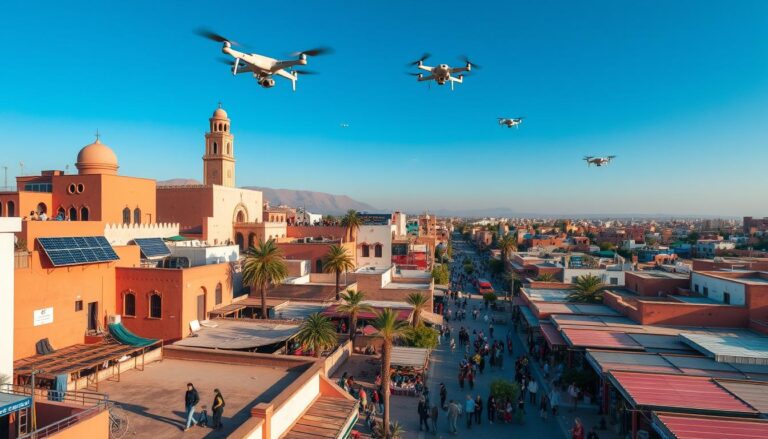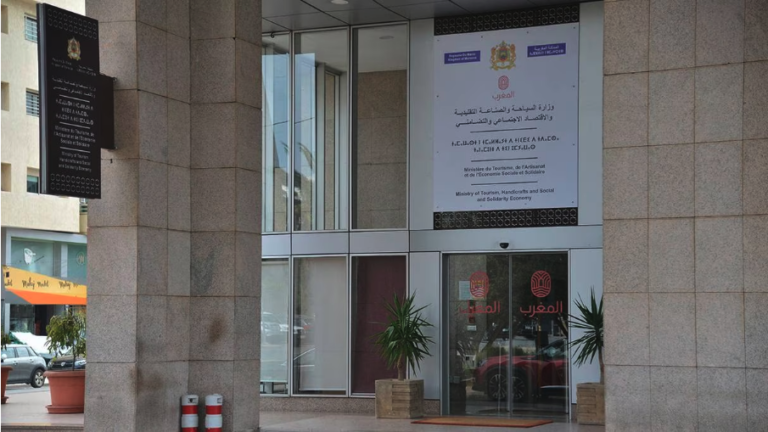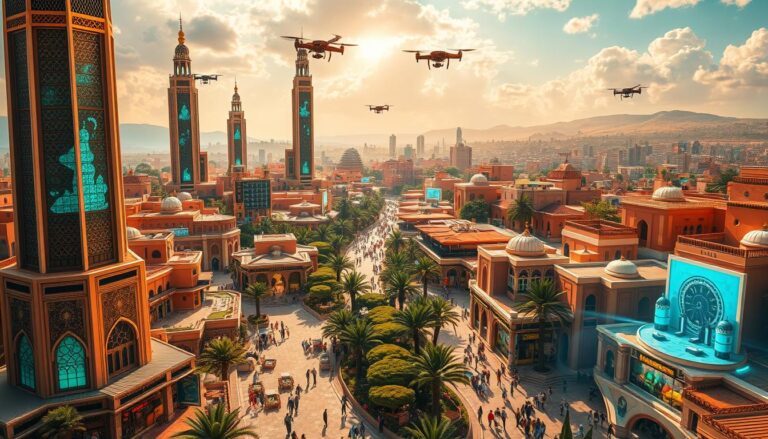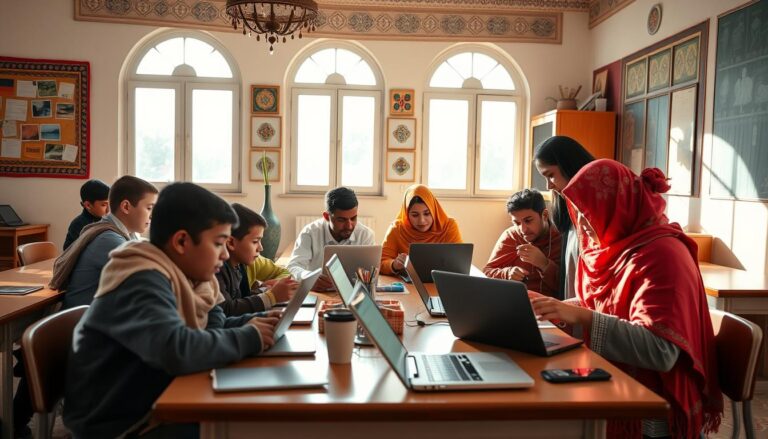Can one African nation lead the green hydrogen revolution? Morocco is setting its sights high with its Green Hydrogen Strategy. It aims to change its energy scene and play a big role in the shift to renewable energy.
Morocco has big goals. It wants to create a 4 terawatt-hour local hydrogen market and export 10 terawatt-hours by 2030. This plan is not just dreams; it’s a real plan to create jobs and grow new energy sources.
The cost of this plan is huge, with estimates between €13 billion and €95 billion from 2020 to 2050. Companies like Total Energies are investing €9.4 billion. This shows Morocco’s big economic chance in hydrogen projects.
Germany is also backing Morocco with €300 million. This money will help develop and get green hydrogen. Morocco’s lots of renewable energy and good location near Europe make it a key player in green hydrogen.
Will Morocco get up to 4% of the global green hydrogen demand by 2030? The data and plans show Morocco is ready to change the energy game. It’s set to make a big impact on a sustainable energy future.
Introduction to Green Hydrogen
Green hydrogen is a big step forward in clean energy. It’s a sustainable choice compared to old fossil fuels. Countries are working hard to reach climate goals, and green hydrogen is key to this effort.
What is Green Hydrogen?
Green hydrogen is made by splitting water using wind and solar power. This method doesn’t release carbon into the air. It’s different from gray hydrogen, which comes from natural gas and has emissions.
Benefits of Green Hydrogen
Green hydrogen has many good points. It’s good for the planet and can be used in many ways. It can power cars, generate electricity, and make chemicals.
It also helps the world get closer to using no carbon at all. This is important for keeping energy stable and safe.
Using green hydrogen is good for the planet and the economy. It helps us use energy in a way that’s better for the environment. Morocco is especially interested in this technology to cut down on carbon and use more renewable energy.
Morocco’s Renewable Energy Landscape
Morocco is a top player in renewable energy, thanks to its natural resources. It’s pushing hard in solar and wind energy. These efforts help Morocco make clean hydrogen and grow in the global energy market.
Solar Energy Initiatives
The Noor Ouarzazate Solar Complex is a key example of Morocco’s solar commitment. It’s a huge solar power plant in the Sahara Desert. Morocco wants to use more renewables, aiming for 52 percent by 2030 and 80 percent by 2050.
Morocco also wants to use less imported fossil fuels. In 2022, these fuels made up 90 percent of its energy. By focusing on solar, Morocco hopes to be more sustainable, cut carbon emissions, and meet global climate goals.
Wind Energy Projects
Morocco’s wind energy projects are also noteworthy, like the Tarfaya Wind Farm. It’s one of Africa’s biggest wind farms. These projects are along Morocco’s windy coasts to boost energy production.
Morocco’s close to Europe makes it a great spot for renewable energy investments. The government supports these efforts with policies to attract international partners and investments. This is for top-notch renewable energy and green hydrogen projects.
With plans to use one million hectares for green hydrogen, Morocco is setting up a strong renewable energy system. It’s focusing on solar and wind to become a global leader in sustainable energy.
The Moroccan Green Hydrogen Strategy
Morocco is aiming to become a key player in the green hydrogen market. This move is part of the country’s commitment to sustainable development. The goal is to meet over 4% of global demand for green hydrogen by 2030.
The country will use its vast renewable energy resources, like solar and wind. It will also use its existing infrastructure to achieve this goal.
The country plans to use about 300,000 hectares of land for these projects. This is just a start, as over 1 million hectares are available. The land will be used for renewable energy generation and turning green hydrogen into products.
Morocco’s strategy focuses on using cheap renewable electricity. This makes the projects profitable and sustainable.
Morocco’s infrastructure is ready for green hydrogen. It has pipelines, desalination plants, and storage caverns. The country’s location also makes it a hub for Europe, boosting investment.
There are incentives like tax breaks for investing in green hydrogen projects. Morocco also has a simple process for project submissions. This helps the green hydrogen industry grow fast.
Morocco is working with countries like Germany on these projects. Germany is investing €2 billion in international hydrogen partnerships. This includes a big industrial hydrogen plant in Morocco, which will cut carbon dioxide emissions by 100,000 tonnes a year.
Green hydrogen has many uses, like in steelmaking and as a fuel for homes. Companies like Engie are finding ways for small businesses to use renewable hydrogen. This shows the sector’s growth potential.
Morocco’s strategy combines public and private efforts. It aims to strengthen the economy and lead in green hydrogen. This move supports sustainable development globally.
Implementation Roadmap: 2020-2030
Morocco is starting a green hydrogen plan. It focuses on making green ammonia locally and exporting green hydrogen. This plan is key to help Morocco meet global goals for reducing carbon emissions.
Local Production of Green Ammonia
Morocco wants to be a big player in green hydrogen. It plans to use its lots of renewable energy to make green ammonia. This will grow the local market and make Morocco known in the green hydrogen world.
By 2030, Morocco hopes to have a hydrogen market of 4 TWh. This growth will come from better use of renewable energy.
Green Hydrogen Export Goals
Morocco aims to send green hydrogen to countries wanting to cut down on carbon. It wants to create an export market of 10 TWh. This will need 6 GW of new renewable energy.
This plan will also create over 15,000 jobs. It shows the big economic benefits Morocco will see. The goal is to increase renewable energy to meet global demand for green hydrogen.
Mid-Term Goals: 2030-2040
Morocco’s green hydrogen strategy for 2030 to 2040 aims to cut production costs and integrate clean energy into key sectors. The global investment in clean energy has grown by 40% from 2020 to 2023. Morocco wants to use this growth to its advantage.
One main goal is to use more green hydrogen in the electricity sector. This aligns with global efforts, like the UAE’s goals at COP28. Morocco plans to improve energy storage to make its electricity supply reliable and sustainable.
Morocco also aims to use green hydrogen more in transportation. This requires building more clean energy infrastructure. Experts say green hydrogen could cost less than USD 2 per kilogram soon. Morocco aims to be a leader in the green hydrogen market by reducing costs.
The strategy also focuses on creating efficient business models and improving the supply chain. These steps are crucial for a clean energy system. By 2050, green hydrogen could meet 12% to 22% of energy demand. Morocco’s efforts from 2030 to 2040 will be key in shaping the energy future.
“To meet ambitious climate goals and limit the rise in global temperatures to 1.5°C, significant growth in renewable power and green hydrogen capacity is essential,” the report suggests. “Strategies outlined in the report could potentially reduce costs by up to 40% in the short term and up to 80% in the long term.”
The mid-term goals for 2030-2040 are crucial for Morocco’s sustainable energy future. By focusing on cost cuts, energy storage, and clean energy infrastructure, Morocco can become a major player in the green hydrogen revolution.
Long-Term Vision: 2040-2050
Morocco has a big plan for the next 30 years. It wants to be a key player in the global hydrogen trade. With lots of renewable energy, Morocco hopes to be a major supplier of green hydrogen worldwide.
Global Hydrogen Trade
Morocco is working on building a strong system for the global hydrogen trade. It plans to invest over $100 billion in green hydrogen. By 2050, Morocco wants to be a big part of the global green hydrogen market.
The country has a lot of renewable energy, with 4,154 MW already in use. It aims to add 131.5 GW more by 2050. This will help Morocco join the global hydrogen market.
Domestic Hydrogen Applications
Morocco also wants to use hydrogen more at home. It plans to use it in industries, transport, and homes. This will help reduce its use of imported fossil fuels, which are over 90% of its energy.
Using green hydrogen locally will help Morocco meet its energy goals. It aims to increase energy efficiency by 20% by 2030. This move is key to Morocco’s goal of leading in innovative energy solutions.
Technological Innovations and Collaborations
Technological progress and global energy partnerships are key for Morocco’s green hydrogen goals. Morocco is working with world leaders in energy to improve hydrogen technology. They aim to make production better and make Morocco a leader in green hydrogen.
Morocco and Germany are teaming up for green hydrogen. They will work together on making green hydrogen and researching new ways to do it. Germany brings tech know-how, while Morocco has lots of sun and wind.
Morocco is also building up its infrastructure. It has a top 20 port, great roads and rails, and a fast train. This makes it ready to export green hydrogen.
Morocco is investing in renewable energy too. It has big solar and wind farms. These projects help Morocco make cheap electricity for hydrogen.
In March 2024, Morocco launched the “Morocco Offer.” It aims to make the green hydrogen sector more competitive. The government also set aside 1 million hectares for green hydrogen projects to attract investors.
Private companies like OCP Group are also playing a big role. They plan to make 200,000 tonnes of green ammonia by 2026. Their goal is to make three million tonnes by 2032. This will help Morocco stand out in the hydrogen market.
Morocco is also tackling water scarcity. It’s investing in sustainable ways to make hydrogen. This not only boosts innovation but also helps the economy and creates jobs.
Morocco’s technological advancements and international energy collaborations underscore its potential to become a green hydrogen powerhouse.
Investment and Economic Impact
Morocco is making a big push for green hydrogen. This move is not just about the environment. It’s also a way to boost the economy.
Industrial Clusters and Financing
Morocco plans to set up special areas for green hydrogen. These areas will have shared facilities like ports and pipelines. This is all part of a big plan to draw in more green energy investments.
The government is setting aside a lot of land for these projects. They’re offering big tax breaks to help investors. This could bring in a lot of money and help Morocco grow its renewable energy sector.
Job Creation and Market Opportunities
The green hydrogen sector in Morocco could create a lot of jobs. Big companies like Total Energies are already on board. This means thousands of jobs could be coming soon.
But it’s not just about jobs. These investments will also help Morocco grow in other areas. They’ll attract money from countries like France and the US. This will help Morocco become more diverse economically.
In short, Morocco’s move into renewable energy is a smart one. It’s creating jobs and helping the economy grow. This is a great time for Morocco’s economy and industry.
Policy Framework and Government Support
Morocco is dedicated to a green future with its national energy strategy. It has a strong policy framework to support green hydrogen projects. The government offers many *government incentives* to draw in investors from around the world.
The country aims to provide 1 million hectares of land for green hydrogen projects. This shows Morocco’s commitment to a sustainable energy future.
“The Moroccan Green Hydrogen Strategy aims to increase the share of renewables in Morocco’s national energy mix to 52% by 2030.”
Investors can benefit from several *government incentives* in the Investment Charter. These include grants and subsidies for renewable energy projects. The selection process is strict, focusing on financial stability and project impact.
The advanced studies phase lasts up to eighteen months. This can be extended if both parties agree. This ensures a smooth start to projects.
MASEN is key for investors. It helps with administrative tasks and infrastructure needs. By 2030, Morocco wants 52% of its electricity to come from renewables.
Law n. 13-09 shows the government’s commitment to renewable energy. Morocco’s policies and investment incentives make it attractive for investors. For example, France will finance a 3GW power link to Western Sahara.
Morocco has a clear plan for a clean future. Its efforts in *policy support* make it a leader in renewable energy and green hydrogen.
Morocco’s Role in the Global Green Hydrogen Market
Morocco is a key player in the green hydrogen industry. Its location near European energy markets is a big plus for exporting green hydrogen. Morocco is committed to growing its renewable energy and aims to be a top exporter in the global green hydrogen market.
Export Potential to Europe
Morocco has set aside 1 million hectares for green hydrogen projects. It plans to start with 300,000 hectares for these projects. By 2030, Morocco hopes to export 10 TWh of green hydrogen, backed by 6 GW of new renewable energy.
The economic benefits of these projects are huge. It’s estimated that the green hydrogen industry will need between 140 billion dirhams (€13 billion) and 1,000 billion dirhams (€95 billion) by 2050. Companies like Total Energies are investing €9.4 billion in Morocco, showing their faith in Morocco’s energy export potential.
Strategic Geographic Advantage
Morocco’s close location to European markets is a big plus for exporting green hydrogen. This makes it cheaper and faster to deliver, making Moroccan green hydrogen competitive in Europe. By 2050, the global green hydrogen market is expected to be 20,000 TWh, with Morocco aiming for 4% of that by 2030.
The Moroccan government wants to attract investors and technology providers to the green hydrogen sector. This move is in line with global sustainability goals and sets an example for other countries investing in green hydrogen.
Morocco is working on improving green hydrogen production technology. This is important to meet the growing demand for green hydrogen worldwide. The creation of over 15,000 jobs by 2030 will also solidify Morocco’s position as a leader in the green hydrogen market.
Conclusion
The Moroccan Green Hydrogen Strategy is a big step towards a sustainable future. It uses the country’s vast renewable energy and strategic location. Morocco is leading the world in green energy, which is good for the environment and the economy.
Right now, almost 90% of Morocco’s energy comes from imported fossil fuels. This shows how much the country wants to change. By 2030, Morocco aims to cut this to 35%, and even less by 2050.
Morocco has big plans, backed by its National Strategy for Sustainable Development 2030. This strategy highlights the role of green hydrogen. The country has set up the Moroccan Agency for Sustainable Energy (Masen) and aims for 42% of electric power from renewables.
In 2020, Morocco got nearly 20% of its electricity from renewables. But they want to do even better in the future. The EU also sees Morocco as key, aiming to buy up to 10 million tonnes of green hydrogen by 2030.
Morocco’s low carbon dioxide emissions show its commitment to the environment. With global hydrogen demand growing, Morocco can play a big role. This will help both the country and the world move towards a greener, more stable future.
Source Links
- Morocco
- Morocco’s Strategic Move in the Green Hydrogen Sector: Unveiling the "Morocco Offer"Article
- A Critical Analysis of Morocco’s Green Hydrogen Roadmap: A Modelling Approach to Assess Country Readiness from the Energy Trilemma Perspective
- Morocco and the Future of Green Hydrogen
- Morocco’s Revolutionary Green Hydrogen Offer – CASCI
- Four Reasons Why Morocco Is Becoming a Renewable Energy Powerhouse
- MASEN – Offre Maroc Hydrogène Vert
- MOROCCO: Partnership with Germany for green hydrogen
- Morocco – United States Department of State
- Green hydrogen helps Morocco to boost energy transition – Green Hydrogen News
- Just Energy Transitions? Lessons From Oman and Morocco
- Green hydrogen cost reduction: Scaling up electrolysers to meet the 1.5C climate goal
- Morocco – Energy
- Morocco’s path to a climate-resilient energy transition: identifying emission drivers, proposing solutions, and addressing barriers
- Morocco’s emergence as a green hydrogen leader – African Association of Entrepreneurs
- Morocco’s green hydrogen offer and opportunities for investors
- Morocco – United States Department of State
- Morocco Green Hydrogen Offer – key takeaways
- Morocco – Investment Climate Statement
- The “Morocco Offer” on green hydrogen: the new governmental plan to encourage investments in the sector
- Morocco’s Energy: Legal Framework & Investment Insights

The Editorial Team is a passionate group of Morocco enthusiasts dedicated to sharing the beauty, culture, and wonders of this captivating country. With diverse backgrounds and a deep love for travel, we strive to bring you engaging and informative content that inspires your Moroccan adventures. From uncovering hidden gems and sharing local insights to exploring mouthwatering cuisine and showcasing the vibrant lifestyle, our team is committed to providing you with valuable resources and exciting stories that enhance your exploration of Morocco. Join us on this journey as we celebrate the rich heritage and unforgettable experiences that make Morocco truly special.







